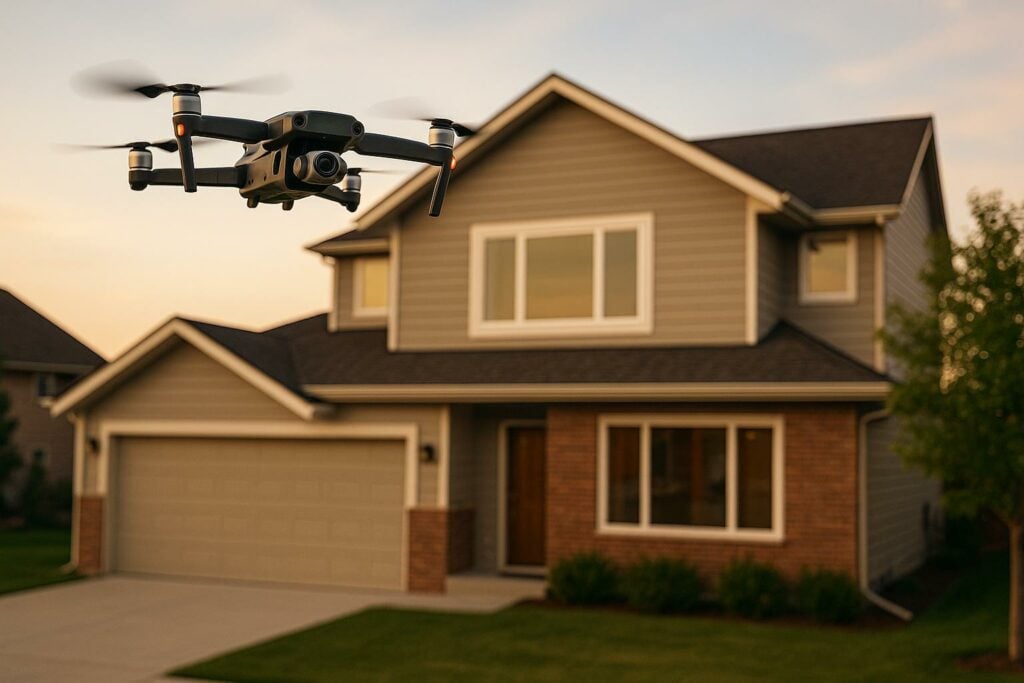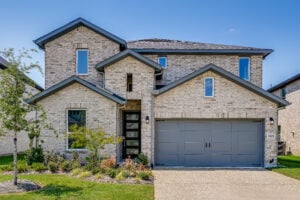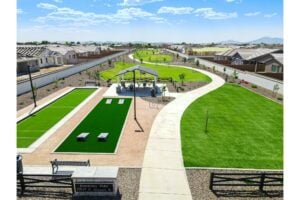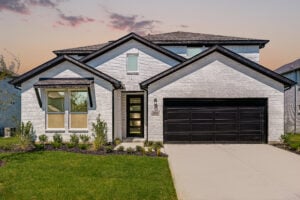Using drones for real estate photography? You need to know the rules. Violating drone privacy laws can lead to fines, lawsuits, or even criminal charges. Here’s what you should focus on:
- FAA Rules: Commercial drone operators must have a Part 107 Remote Pilot Certificate, follow altitude limits, and get approval for restricted airspace.
- State Laws: Privacy laws differ by state. For example, Texas bans unauthorized aerial surveillance, while California protects areas with a "reasonable expectation of privacy."
- Consent: Always get permission before flying over private property. Inform neighbors to avoid disputes.
- Data Security: Encrypt files, use secure storage, and limit access to sensitive images.
- Copyright: Clarify ownership of drone footage to avoid legal issues.
How To Fly Drones In A Neighborhood Legally? (YDQA Ep 74)
Federal and State Drone Privacy Rules
Understanding federal and state drone regulations is crucial for capturing aerial footage while respecting privacy rights.
Federal Aviation Administration (FAA) Rules
The FAA governs all drone operations, with its primary focus on aviation safety. For commercial real estate photography, operators must hold a Part 107 Remote Pilot Certificate and follow specific guidelines. These include keeping the drone within visual line of sight, flying below 400 feet in uncontrolled airspace, and obtaining prior authorization for operations in controlled airspace through the Low Altitude Authorization and Notification Capability (LAANC) system.
Although the FAA prioritizes safety over privacy, its rules – like those for low-altitude flights – can inadvertently increase the likelihood of capturing sensitive details. Additionally, operators must adhere to strict no-fly zones, which include airports, military bases, national parks, and areas under temporary flight restrictions. Violating these restrictions can lead to hefty civil fines and, in some cases, criminal charges.
State Privacy Laws
State laws addressing drone privacy vary widely, creating a complex network of regulations. For instance, Texas has laws targeting unauthorized aerial surveillance, making it clear that capturing images of private property or individuals without consent can result in civil liability. In California, the concept of a "reasonable expectation of privacy" applies, meaning areas like backyards may be protected, while photos taken from public spaces are treated differently. Similarly, Florida has introduced measures requiring operators to notify property owners if their activities might capture private spaces. These examples highlight how state-specific rules can affect drone operations, emphasizing the importance of distinguishing between public and private property to remain compliant.
Public vs. Private Property: When Consent Is Needed
Navigating consent requirements is essential when operating drones. The distinction between public and private property significantly impacts when permission is necessary. Generally, flying over public areas – such as streets, parks, or sidewalks – does not require consent from local authorities, provided FAA guidelines are followed. However, capturing images of private property or individuals from public airspace may trigger state privacy laws, which often require consent.
Even when hired to photograph a specific property, drone operators might unintentionally capture neighboring homes, backyards, or other private spaces where people have a reasonable expectation of privacy. Securing consent from affected property owners can help reduce legal risks. Additionally, commercial drone operations often face stricter requirements compared to recreational use, making compliance even more critical.
How to Store and Protect Drone Data
Securing drone images is just as important as adhering to flight regulations. For real estate professionals, protecting sensitive property data is not just about compliance – it’s about maintaining client trust and ensuring smooth operations.
Data Encryption and Storage Security
Encryption is your first line of defense when it comes to drone data. Make sure all media files are encrypted during both transmission and storage. This can be achieved using secure devices and protocols that meet current security standards.
Cloud storage platforms such as Google Drive for Business, Microsoft OneDrive, and Dropbox Business are popular choices. These services typically use AES-256 encryption, which is often referred to as military-grade security. However, it’s essential to verify that the platform you choose complies with industry standards and provides access logs. These logs can help track who accessed files and when, adding an extra layer of accountability.
Access controls are another critical component. Limit access to drone files to only those team members who need them for their specific tasks. Use multi-factor authentication (MFA) for all accounts to reduce the risk of unauthorized access. Regularly review user permissions to ensure that former employees or contractors no longer have access to sensitive data. For clients, consider using time-limited access links to share property media securely.
If you’re storing data locally, take extra precautions. Use dedicated drives for drone data and ensure they are physically secured when not in use. Avoid storing sensitive property images on personal devices or unsecured network drives, as these could be vulnerable to unauthorized access.
By combining encryption, access controls, and secure storage practices, you can build a strong defense against potential cybersecurity threats.
Cybersecurity Threats and Protection
Cybersecurity threats, particularly data breaches, pose a significant risk to real estate operations. Hackers often target valuable property data, and even a single breach could expose dozens of listings and compromise client privacy.
Ransomware attacks are a growing concern in the real estate sector. These attacks involve encrypting accessible files, including drone imagery, and demanding payment to unlock them. To mitigate this risk, schedule regular automated backups and store them offline or in immutable cloud storage. This ensures you can recover your data without succumbing to ransom demands.
Network security is another key area to focus on. Use firewalls, keep software updated, and always transfer files through secure connections. For instance, a mobile hotspot with a VPN is a safer option than public Wi-Fi when transferring sensitive data.
Employee training is equally important. Your team should be able to identify phishing emails designed to steal login credentials or install malware. Conduct regular security awareness sessions to keep everyone up to date on the latest threats and best practices.
Implementing strong cybersecurity measures not only protects your data but also helps ensure compliance with copyright and data ownership regulations.
Copyright and Data Ownership Rights
In addition to securing your data, it’s crucial to establish clear copyright agreements when working with drone photography services. The National Association of REALTORS® recommends addressing copyright ownership in your contracts: "Define copyright ownership of the photos and videos to be taken of your listings in your contract".
Usage rights dictate how the images and videos captured by drones can be used, shared, or modified. Some photographers retain copyright and grant limited usage licenses, while others transfer full ownership to their clients. Legal experts like Hackstaff, Snow, Atkinson & Griess, LLC stress the importance of having "a clear understanding of copyright and usage of the resulting images or videos". Without proper documentation, you could face legal challenges when using these images for marketing purposes, whether on websites, social media, or other platforms.
Licensing agreements should clearly outline the terms of use. Specify whether the images can be used indefinitely, shared with multiple listing services, or edited for various marketing campaigns. Some contracts may include restrictions on editing or require photographer attribution. Services like HomeJab often provide clear ownership transfer, allowing real estate professionals to use aerial photography without worrying about ongoing licensing restrictions.
To further protect your intellectual property, maintain detailed records of flights, permissions, and contracts with photographers. These records can serve as evidence of proper authorization, safeguarding you against future copyright disputes or privacy claims.
Legal Compliance Steps for Real Estate Professionals
Ensuring legal compliance in drone operations isn’t just about following the rules – it’s about creating a proactive approach to protect sensitive data, maintain trust, and avoid costly pitfalls like data breaches or intellectual property theft. A key part of this process? Comprehensive staff training and policy updates.
Regular training sessions should dive into the essentials: data protection protocols, confidentiality requirements, and safe operating procedures for managing drone imagery and client information. Keeping up with privacy issues is also a must, as it helps operators stay aligned with evolving regulations. These sessions should focus on securely handling and storing data, preventing unauthorized access, and adhering to privacy laws. This kind of ongoing education lays the groundwork for an ethical, compliance-driven approach that benefits both businesses and their clients.
To go above and beyond, businesses should foster a culture of confidentiality. This means providing training that not only meets but exceeds basic legal requirements. Employers need to ensure that drone operators are consistently educated on both operational protocols and data security standards. Certification for these training programs is also important – it demonstrates a commitment to compliance and accountability.
As privacy laws continue to evolve, training programs should be regularly updated to reflect the latest regulations. It’s equally important to document all training sessions and certifications to maintain a clear record of compliance efforts. If you’re using services like HomeJab, take the extra step to ensure your team understands how professional photography providers handle data security and privacy. This ensures consistent standards across all drone operations and helps protect your business and clients alike.
sbb-itb-82c5f45
How to Avoid Legal Problems with Drone Photography
For real estate professionals, drones offer a fantastic way to capture stunning property visuals. But with great tools come great responsibilities. Misusing drones can lead to lawsuits or regulatory trouble, so understanding the risks and taking precautions is crucial.
Avoiding Privacy Violations
One of the biggest legal risks? Trespass-by-drone. This happens when a drone captures images of private property – think pools, backyards, or even views through windows – without the owner’s consent. In a well-known 2016 case in Utah, a drone was found outside a bathroom window, filled with unauthorized photos and videos of people near their apartments. Incidents like this highlight just how serious privacy concerns can be.
So, what can you do? First, always get explicit permission from property owners and anyone else who might be affected. Studies show that people are often wary of drones flying over their homes. Especially in densely packed neighborhoods, transparency goes a long way. Let nearby residents know if you’ll be using drones for aerial footage. This simple step can build trust and prevent misunderstandings before they escalate.
Also, remember that certain actions – like using drones to harass, intimidate, or spy – are clear violations. For example, capturing images through home windows or over fenced-in backyards is a big no-no.
If you accidentally record private property or individuals, edit the footage before posting it online. Blurring out identifying details, like license plates or house numbers, is a smart way to protect privacy when using drone footage for MLS listings or other platforms. Alongside respecting privacy, handling data responsibly is just as important.
Preventing Data Misuse and Copyright Issues
Beyond privacy concerns, data misuse and copyright issues can add another layer of complexity. While the FAA mainly focuses on airspace safety, state and local laws often address privacy, creating a patchwork of regulations that real estate professionals must navigate.
To stay on the safe side, keep thorough records. Document all permissions – written consents from property owners and neighbors can be invaluable if a dispute arises. Partnering with FAA-certified drone pilots who are well-versed in local, state, and federal laws is another way to reduce risks.
Operating in different areas? Be prepared to adapt. As the Pilot Institute points out:
"While informing others that you’re flying is a good practice, pilots also need to know that random people can’t legally tell them to stop flying. If someone doesn’t like it, that’s unfortunate – but it’s not a valid reason to prevent someone from flying or to harass them while they do."
This highlights the importance of researching and understanding the specific drone regulations in each location where you operate.
Another key consideration is copyright ownership. Before you start snapping photos, establish clear agreements about who owns the rights to the images and videos. Decide how they can be used and for how long. If you’re working with professional photography services like HomeJab, ensure their practices align with your legal obligations and your clients’ expectations.
Regular Compliance Reviews
Even with the best intentions, staying compliant requires ongoing effort. Regular audits can help you catch potential issues before they become problems. Consider scheduling quarterly reviews to check permission records, data storage practices, staff training, and insurance coverage. This ensures your operations stay aligned with the latest federal, state, and local rules.
Keeping up with regulations is a must. Sign up for updates from aviation authorities, legal groups, and industry organizations to stay informed about changes. And don’t hesitate to consult legal experts who specialize in drone laws – they can help you navigate the fine print while protecting your reputation and your clients’ trust.
Key Points for Drone Privacy and Legal Compliance
To ensure you’re operating drones responsibly, it’s crucial to follow both FAA guidelines and state-specific regulations. While the FAA oversees airspace safety and registration, privacy concerns and data protection often fall under the jurisdiction of state and local laws. Balancing these layers of regulation is key to staying compliant.
Documentation is a must. Always get written consent from property owners before flying over private property. Additionally, inform nearby residents about your plans. Taking these steps not only builds trust but also helps avoid conflicts that could lead to legal issues.
Data protection doesn’t stop when the drone lands. Make sure all footage is encrypted, clarify who owns the copyright to the content, and train your team on the privacy laws that apply in your area. If you’re working with a professional service provider, confirm they follow both legal requirements and your client’s expectations.
After securing your data, regular monitoring is essential. Conduct quarterly reviews of permissions, data storage practices, and insurance policies to ensure you’re staying compliant. Regulations are constantly changing, so staying updated through aviation authorities and industry groups is critical to protecting your business and keeping your clients’ trust.
The upfront costs of training, insurance, and compliance systems are small compared to the potential fallout from privacy violations or data breaches. By taking these precautions, you’re not just protecting your business – you’re also respecting the privacy of the community you serve.
FAQs
What are the legal risks of breaking drone privacy laws in the United States?
Violating drone privacy laws in the U.S. can lead to serious legal trouble, with consequences ranging from fines to criminal charges. In many states, unauthorized drone surveillance is treated as a misdemeanor, which might result in fines or even short-term jail time. However, more severe cases – like spying on minors or flying over restricted areas – can escalate to felony charges, carrying potential prison sentences of up to 10 years.
Flying a drone over someone’s private property without their consent can also be considered trespassing or an invasion of privacy. This could open the door to lawsuits or criminal charges. On top of that, the FAA has the authority to impose hefty fines – up to $75,000 per violation – and may suspend or revoke drone pilot certifications for breaking the rules. To stay out of trouble, always make sure to follow both local and federal drone regulations.
What steps should drone operators take to comply with U.S. privacy laws when capturing aerial footage for real estate?
Understanding U.S. Privacy Laws for Drone Operators
To operate drones responsibly within the U.S., it’s crucial to follow federal guidelines and stay up-to-date with state-specific rules. Here are some essential practices to keep in mind:
- Always keep your drone within your visual line of sight while flying.
- Refrain from flying over people, private property, or restricted areas unless you have the necessary permissions.
- Perform pre-flight safety checks and ensure your drone is properly registered, if required by law.
While the Federal Aviation Administration (FAA) oversees drone safety regulations, privacy concerns are often handled at the state level. Some states may enforce rules requiring property owner consent or limit drone activity near private properties. Additionally, it’s important to respect privacy boundaries, such as avoiding any actions that might be seen as intrusive or resembling surveillance.
For those using drones to capture aerial footage – like in real estate – it’s especially critical to stay informed about both federal and state laws to ensure compliance.
How can I protect drone data and prevent unauthorized access or breaches?
To keep your drone data secure and out of the wrong hands, start by enabling encryption for both data transmission and storage. This step ensures that sensitive information is accessible only to those with proper authorization. Another critical measure? Regularly update your drone’s firmware and software to patch any potential security gaps.
Strengthen your defenses further by setting up strict access controls. Use strong passwords and add an extra layer of protection with multi-factor authentication. Also, be mindful of portable storage devices like SD cards – don’t leave them unattended or inserted when they’re not actively needed. These simple but effective steps can go a long way in safeguarding your drone data from breaches.











